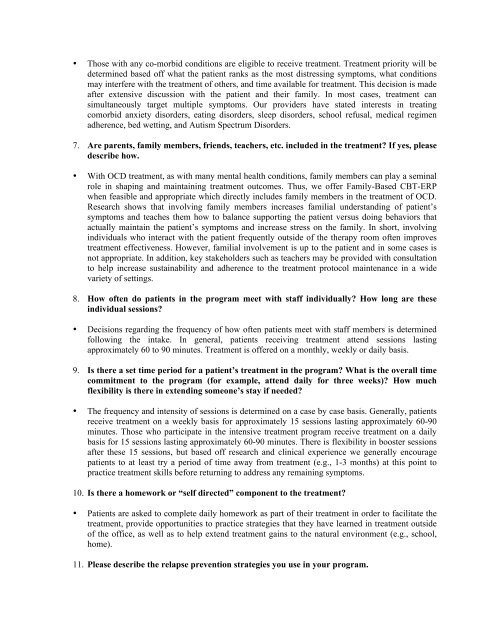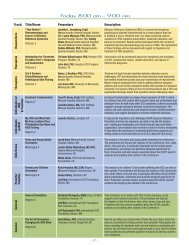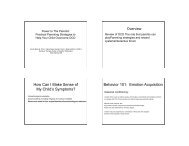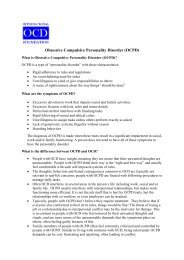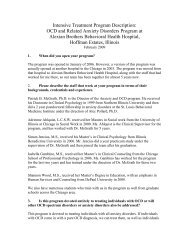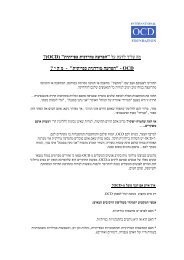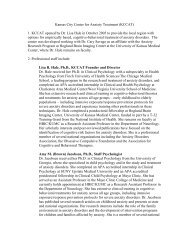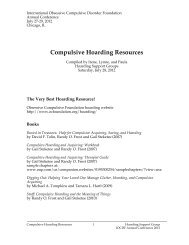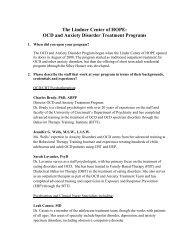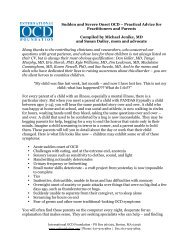Detailed Program Description - Obsessive Compulsive Foundation
Detailed Program Description - Obsessive Compulsive Foundation
Detailed Program Description - Obsessive Compulsive Foundation
You also want an ePaper? Increase the reach of your titles
YUMPU automatically turns print PDFs into web optimized ePapers that Google loves.
• Those with any co-morbid conditions are eligible to receive treatment. Treatment priority will be<br />
determined based off what the patient ranks as the most distressing symptoms, what conditions<br />
may interfere with the treatment of others, and time available for treatment. This decision is made<br />
after extensive discussion with the patient and their family. In most cases, treatment can<br />
simultaneously target multiple symptoms. Our providers have stated interests in treating<br />
comorbid anxiety disorders, eating disorders, sleep disorders, school refusal, medical regimen<br />
adherence, bed wetting, and Autism Spectrum Disorders.<br />
7. Are parents, family members, friends, teachers, etc. included in the treatment If yes, please<br />
describe how.<br />
• With OCD treatment, as with many mental health conditions, family members can play a seminal<br />
role in shaping and maintaining treatment outcomes. Thus, we offer Family-Based CBT-ERP<br />
when feasible and appropriate which directly includes family members in the treatment of OCD.<br />
Research shows that involving family members increases familial understanding of patient’s<br />
symptoms and teaches them how to balance supporting the patient versus doing behaviors that<br />
actually maintain the patient’s symptoms and increase stress on the family. In short, involving<br />
individuals who interact with the patient frequently outside of the therapy room often improves<br />
treatment effectiveness. However, familial involvement is up to the patient and in some cases is<br />
not appropriate. In addition, key stakeholders such as teachers may be provided with consultation<br />
to help increase sustainability and adherence to the treatment protocol maintenance in a wide<br />
variety of settings.<br />
8. How often do patients in the program meet with staff individually How long are these<br />
individual sessions<br />
• Decisions regarding the frequency of how often patients meet with staff members is determined<br />
following the intake. In general, patients receiving treatment attend sessions lasting<br />
approximately 60 to 90 minutes. Treatment is offered on a monthly, weekly or daily basis.<br />
9. Is there a set time period for a patient’s treatment in the program What is the overall time<br />
commitment to the program (for example, attend daily for three weeks) How much<br />
flexibility is there in extending someone’s stay if needed<br />
• The frequency and intensity of sessions is determined on a case by case basis. Generally, patients<br />
receive treatment on a weekly basis for approximately 15 sessions lasting approximately 60-90<br />
minutes. Those who participate in the intensive treatment program receive treatment on a daily<br />
basis for 15 sessions lasting approximately 60-90 minutes. There is flexibility in booster sessions<br />
after these 15 sessions, but based off research and clinical experience we generally encourage<br />
patients to at least try a period of time away from treatment (e.g., 1-3 months) at this point to<br />
practice treatment skills before returning to address any remaining symptoms.<br />
10. Is there a homework or “self directed” component to the treatment<br />
• Patients are asked to complete daily homework as part of their treatment in order to facilitate the<br />
treatment, provide opportunities to practice strategies that they have learned in treatment outside<br />
of the office, as well as to help extend treatment gains to the natural environment (e.g., school,<br />
home).<br />
11. Please describe the relapse prevention strategies you use in your program.


